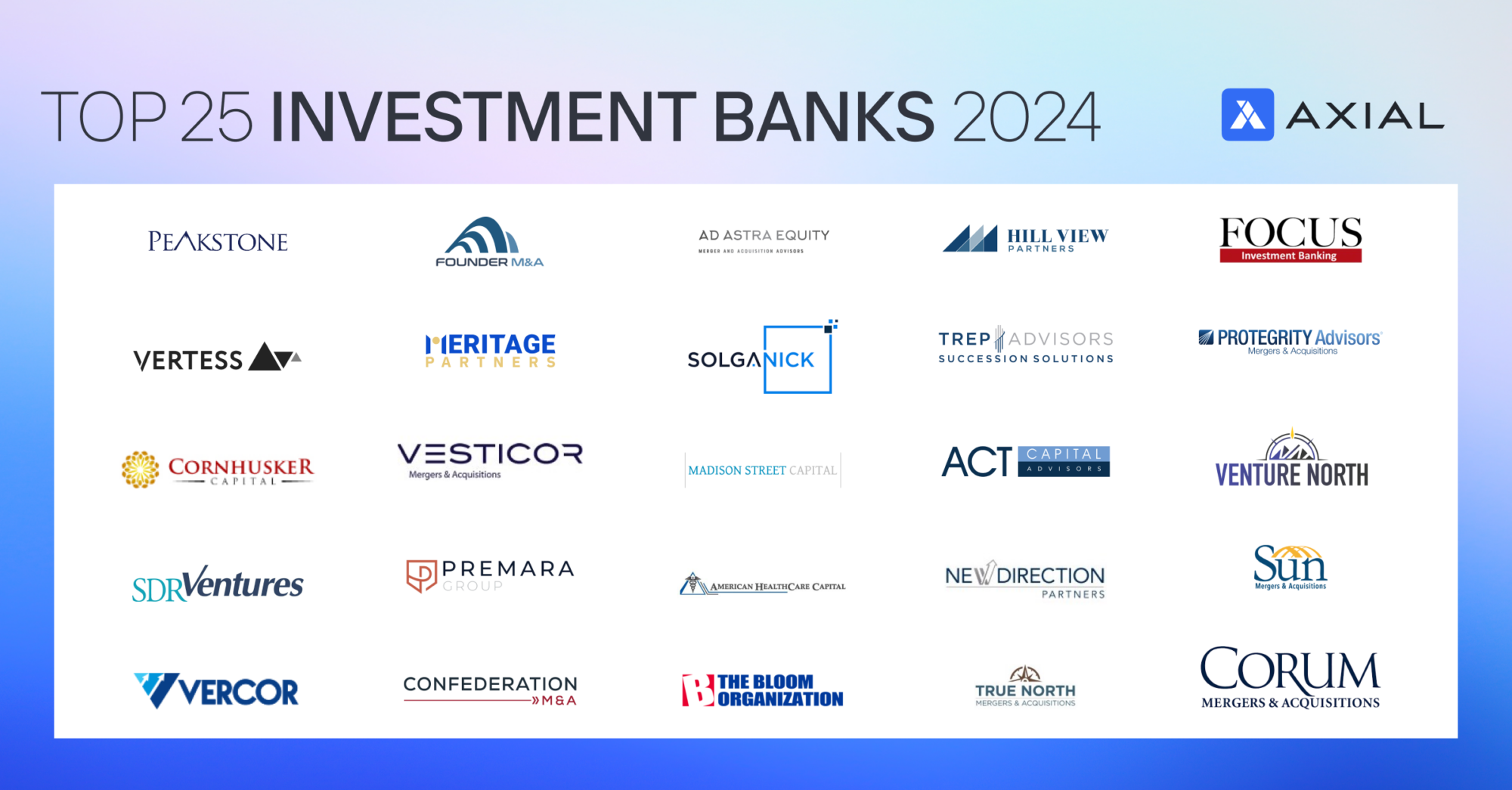
Top 25 Lower Middle Market Investment Banks | 2024
Axial is excited to release our 2024 Lower Middle Market Investment Banking League Tables. To assemble this list, we reviewed…
Tags
Read Part 1 of this article first: How Today’s Deal Professionals Use CRMs
Once you’ve decided to make the leap and implement a CRM system, it’s important to set attainable goals for the organization well before implementation begins. These goals will become the basis for your implementation plan. More goals doesn’t necessarily equate to more development cost because over the past 10 years CRM developers have built systems to accomplish 80% – 90% of the things most investment shops are looking for. The more specific and detailed your planning is, the more successful and cost effective your implementation will be.
There are certain basic concepts to keep in mind when setting goals and designing and implementing any data management system. The most important is understanding the difference between structured and unstructured data and the importance of developing systems that can track both forms. Experts estimate that 80 to 90 percent of the data in any organization is unstructured. Unstructured data includes e-mail messages, word processing documents, photos, presentations, webpages and many other kinds of business documents. While these types of files may have an internal structure, they are still considered “unstructured” because the data they contain doesn’t fit neatly in a database. Your ability to efficiently search and access your firm’s unstructured data will be something you always want to maintain. Products like Evernote make for a great unstructured data base solution. Holding massive amounts of data in quick searchable form is a great beginning building block before committing to a full-blown CRM system.
Structured data has the advantage of being easily stored, queried and analyzed. Structured data sets should allow for records to be easily connected to other records. This is why most CRMs are referred to as relational databases. The ability to link a deal to a referral source to a business development activity creates a powerful ability to provide the user with quick context around countless business situations. Think of the importance of having all of this connected and readily accessible information at your fingertips before meeting with a client, CEO, banker, limited partner, or a host of other relationship types.
Structuring data first depends on creating a data model which can be developed based on the types of business data that will be recorded, stored, processed and accessed. This includes defining what fields of data will be stored, the data type (numeric, alphabetic, date, etc.), and any restrictions. It’s a process that is necessary to ensure the least amount of headache during the actual development and implementation process. As the saying goes, measure twice, cut once. It’s important to involve a broad range of employees during the planning – from the analyst that’s responsible for logging deal information to the executive who wants the right dashboard reports so they know what’s happening with the business today.
1. Structure only the data that you plan to measure and manage. Structuring data takes time and resources (i.e., money) and investment professionals tend to become frustrated when they’re asked to input data they know is meaningless. Why track the number of turns of a letter of intent unless that is something you really care about managing? If you want your CRM implementation to go smoothly, spend the time explaining (or at least showing) how the information you are structuring will be used to manage and improve the business development function.
2. Build a CRM system that maximizes data integrity. There are three enemies of data integrity: duplicate data, incomplete data, and inaccurate data. Data integrity is of paramount importance when dealing with structured data because without it, reporting becomes unreliable and the system will become unwieldy. This is the main reason Excel is not an appropriate solution for data management on the backend (however, Excel remains the best tool for CRM reporting given the power of pivot tables and graphs).
Duplicate data creates havoc in a CRM and waste time and resource as the employee is forced to go to multiple sources to piece an answer together. Duplicates are best avoided at the system level (CRM self-detection) or by restricting the addition of certain types of records to specific employees (i.e., adding a new company to the CRM).
Incomplete data can be mitigated by making certain fields required (i.e.,deal name and source) and by requiring certain types of data to be input when milestones are reached (i.e., when you issue a term sheet a prompt occurs requiring the associate to input the specific deal terms).
Inaccurate data is the most difficult issue to solve for because humans make mistakes that often fall within the range of reasonableness. A 6.5 times EBITDA multiple mistakenly keyed in as 5.6 times EBITDA will be hard for someone to catch. The best way to minimize the impact of inaccurate data is to make the most important data that you manage very prominent in your CRM reporting. If purchase price multiples are important to you, they better appear prominently on any reporting coming out of the CRM. These mistakes are often caught during pipeline review meetings which our firm holds on a weekly basis.
3. Maximize your CRM’s ability to link data and records across the entire system. The main point of a relational data base is to link information so that a user can gain rapid context. When the managing partner of my firm asks me about a deal that just closed and whether or not we saw it I am able to very quickly tell him yes, we saw the deal, from investment bank XYZ, who we met with 2 months ago, at the ACG Capital Connection in Denver, which we have attended for 3 years, which has generated 20 new relationships, that have generated 50 other deals, of which 1 closed. That previous sentence is a mouthful, but the point is a CRM provides management the ability to gauge Return on Investment, a key principle in the business world.
4. Focus on building the majority of the CRM backend system first before you focus on building the reports that you will use to manage the business development function. I can’t stress this point enough and it will save you hours of frustration. Changes to the CRM’s internal function often impact the data coming out of the system. Many CRM systems rely on Excel and its very powerful pivot table functionality for CRM reporting. Pivot tables hate when their data sets change and I can’t tell you how many hours of report development I would have saved if I spent more time planning the record and field design before I set off on the development of reports.
5. Encourage user adoption by highlighting good and bad behavior. Hopefully you’ve designed and built a CRM that your colleagues want to use because it is intuitive and user friendly. Be sure to spend time beta testing prior to launching the system firm wide. As my mother used to tell me you only get one chance to make a first impression and no truth is closer when it comes to the launch of a CRM. If your colleagues hate the system or don’t receive the proper training on the tool they won’t use it. Even with a great CRM, certain colleagues will still fail to use the system properly for a myriad of reasons. Be sure the tone at the top of your organization is supportive of the CRM development and ensure those who fail to use it face some consequence.
6. Talk amongst yourselves. From the planning stage to the steady state phase — a CRM system cannot live in a vacuum. When planning your CRM build, include individuals from the top to the bottom of the totem pole. And the reports generated from the system aren’t meant to be buried in the executive suite. At our firm every employee receives a weekly report updating them on deal flow, business development activities, market conditions, and other metrics that matter to us. We also build in CRM enhancement cycles which help us enhance our system on a scheduled basis based on feedback from across the entire firm.
7. Make sure your CRM works just as well on a mobile device as it does on the desktop. We’ve all been in the situation where a meeting is about to begin, and you can’t remember the details of a deal they shared with you 4 months ago. Making sure your CRM is accessible on every type of device is crucial.
Customer Relationship Management technology will continue to evolve and improve but at its core it should provide your firm with a straightforward way to keep organized, maximize productivity, track productivity, and judge the success and progression of your firm’s business development efforts.
